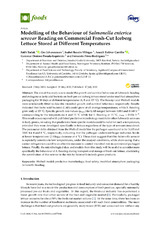Mostrar el registro sencillo del ítem
Modelling of the Behaviour of Salmonella enterica serovar Reading on Commercial Fresh-Cut Iceberg Lettuce Stored at Different Temperatures
| dc.contributor.author | Tarlak, Fatih | |
| dc.contributor.author | Johannessen, Gro | |
| dc.contributor.author | Bascón-Villegas, Isabel | |
| dc.contributor.author | Bolívar Carrillo, Araceli | |
| dc.contributor.author | Posada Izquierdo, Guiomar Denisse | |
| dc.contributor.author | Pérez-Rodríguez, Fernando | |
| dc.date.accessioned | 2020-07-17T20:27:33Z | |
| dc.date.available | 2020-07-17T20:27:33Z | |
| dc.date.issued | 2020 | |
| dc.identifier.uri | http://hdl.handle.net/10396/20312 | |
| dc.description.abstract | The aim of this study was to model the growth and survival behaviour of Salmonella Reading and endogenous lactic acid bacteria on fresh pre-cut iceberg lettuce stored under modified atmosphere packaging for 10 days at different temperatures (4, 8 and 15 °C). The Baranyi and Weibull models were satisfactorily fitted to describe microbial growth and survival behaviour, respectively. Results indicated that lactic acid bacteria (LAB) could grow at all storage temperatures, while S. Reading grew only at 15 °C. Specific growth rate values (μmax) for LAB ranged between 0.080 and 0.168 h−1 corresponding to the temperatures 4 and 15 °C while for S. Reading at 15 °C, μmax = 0.056 h−1. This result was compared with published predictive microbiology models for other Salmonella serovars in leafy greens, revealing that predictions from specific models could be valid for such a temperature, provided they were developed specifically in lettuce regardless of the type of serovars inoculated. The parameter delta obtained from the Weibull model for the pathogen was found to be 16.03 and 18.81 for 4 and 8 °C, respectively, indicating that the pathogen underwent larger reduction levels at lower temperatures (2.8 log10 decrease at 4 °C). These data suggest that this Salmonella serovar is especially sensitive to low temperatures, under the assayed conditions, while showcasing that a correct refrigeration could be an effective measure to control microbial risk in commercial packaged lettuce. Finally, the microbiological data and models from this study will be useful to consider more specifically the behaviour of S. Reading during transport and storage of fresh-cut lettuce, elucidating the contribution of this serovar to the risk by Salmonella in leafy green products. | es_ES |
| dc.format.mimetype | application/pdf | es_ES |
| dc.language.iso | eng | es_ES |
| dc.publisher | MDPI | es_ES |
| dc.rights | https://creativecommons.org/licenses/by/4.0/ | es_ES |
| dc.source | Foods 9(7), 946 (2020) | es_ES |
| dc.subject | Weibull model | es_ES |
| dc.subject | Predictive microbiology | es_ES |
| dc.subject | Food safety | es_ES |
| dc.subject | Modified atmosphere packaging | es_ES |
| dc.subject | Salmonella Reading | es_ES |
| dc.title | Modelling of the Behaviour of Salmonella enterica serovar Reading on Commercial Fresh-Cut Iceberg Lettuce Stored at Different Temperatures | es_ES |
| dc.type | info:eu-repo/semantics/article | es_ES |
| dc.relation.publisherversion | http://dx.doi.org/10.3390/foods9070946 | es_ES |
| dc.relation.projectID | info:eu-repo/grantAgreement/EC/FP7/222738 (BASELINE) | es_ES |
| dc.rights.accessRights | info:eu-repo/semantics/openAccess | es_ES |

